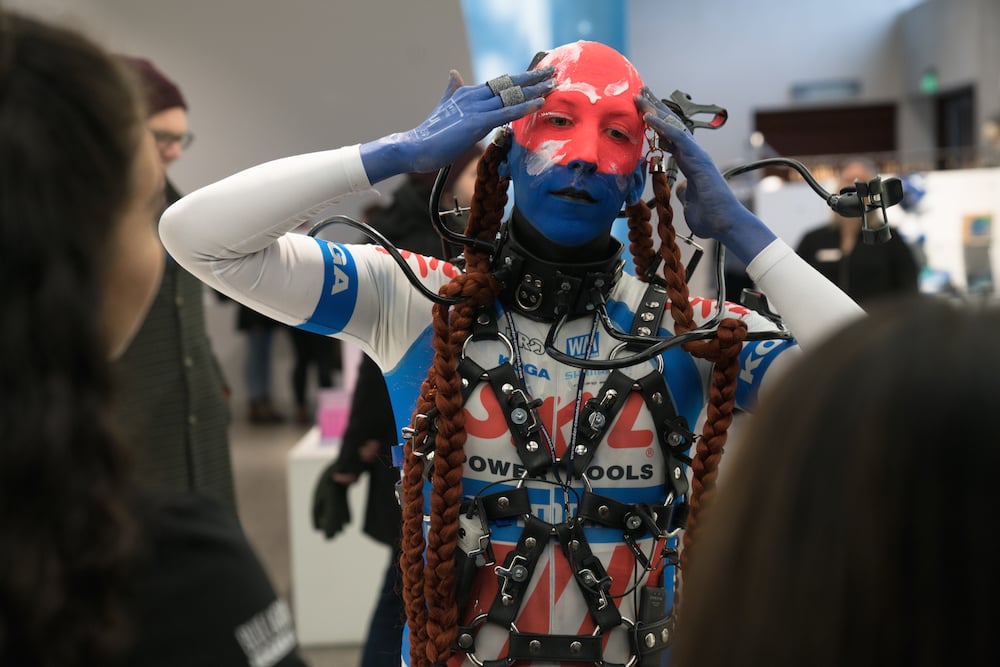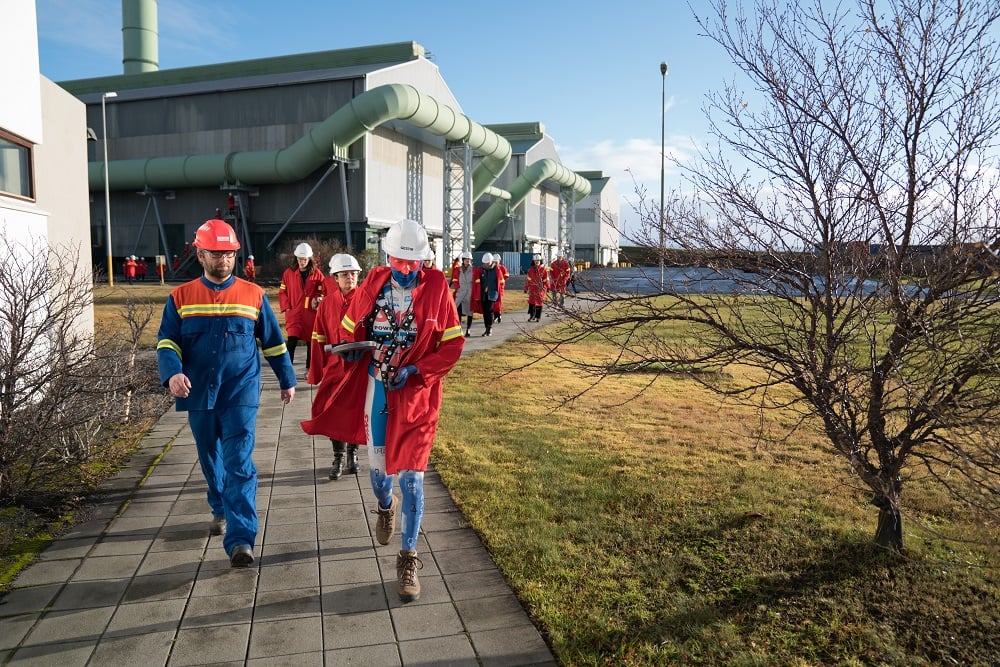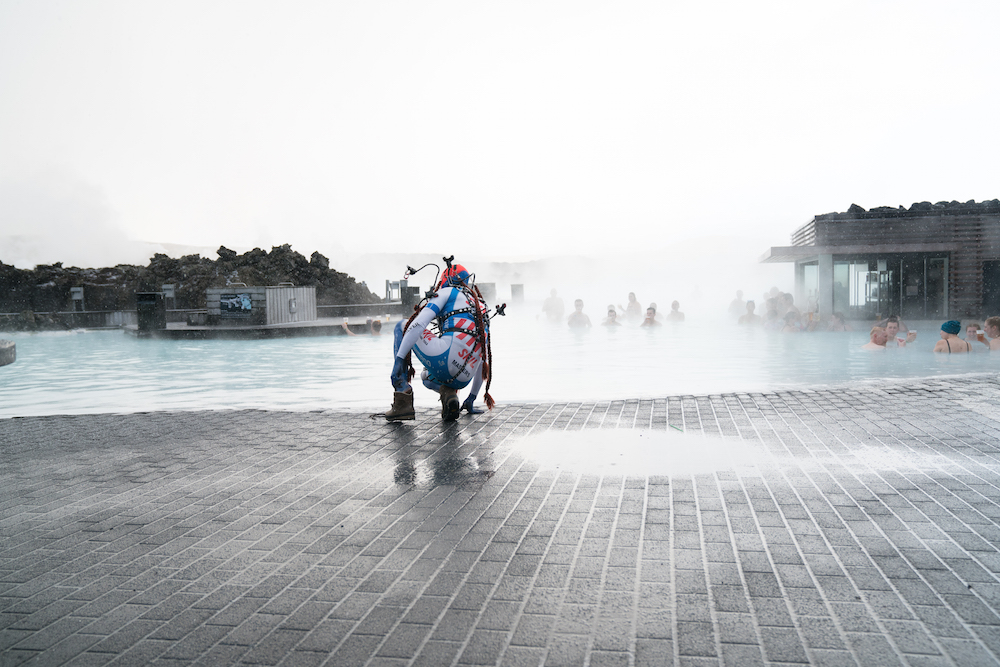Reviews
Who’s the Artist Behind the Genderless, Rare-Earth Loving Tech Witch?
Following one performance, the Apple Store in Berlin was evacuated.

Following one performance, the Apple Store in Berlin was evacuated.

Hili Perlson

This past summer, on July 9 to be exact, the Apple Store on Berlin’s main shopping drag, the Ku’Damm, was evacuated and shut down by police. The culprit? A self-described “Witch” called Protectorama, a bizarre apparition clad in a leather-strap bodysuit with multiple gnarled selfie-sticks attached to its metal loops, worn over a branded, red-white-and-blue cycling suit, with any exposed skin, from head to fingertips, covered in blue and red body paint.
The genderless being was performing a ritual using a metal called Gallium that melts at approximately body temperature with a group of people. Organized as part of a performance festival, the witch’s ritual was meant to raise critical questions about our fetishization of the iPhone and other Apple products, which all contain Rare Earth elements and metals of which most of us know nothing about.
But the store alarmed the police, thinking the metal was poisonous quicksilver, and the performer, a terrorist.
Arrests were made, the festival organizers apologized, and the German media went berserk, relishing in the opportunity to slam contemporary art in hysterical news writing (one tabloid gave it the cover, and titled their article “What an Idiot”).

Johannes Paul Raether as Protecto Alum. Photo by Hörður Sveinsson, Courtesy Cycle Festival for Art and Music
Undeterred by this extreme reaction to his “infiltration of the iPhone cathedral” as he puts it in an interview with artnet News, the brush with the law didn’t stop Johannes Paul Raether, the German artist who conjured up the Rare Earth-elements-loving witch, from evoking “them” again. “It’s a herd, a tribe of witches” he explains, shifting in and out of character when we speak. “Apparitions of witches from the species of Protectoramae show up in different places.”
The latest version of the Protectorama genre appeared in Iceland in late October, as part of the CYCLE music and art festival. The targets this time were two sites embodying two of the island’s major revenue sources: an aluminum smelter, and a popular tourist resort built around a geothermal spa rich in sulfur and silica.
The witch’s tool is language: As a group of artists, critics, and festival visitors boarded a tourist bus from Reykjavik’s central bus station, the witch began to prepare us, relating factual details about aluminum and its production, peppered with ingenious neologisms and word composita such as “techno-alchemy” (giving occult status to elements found in everyday technology) or “Capitalotrophic addiction.”
Once inside the aluminum factory, the group was welcomed by an employee who was open to host the unusual artwork there, and after donning safety equipment and an earpiece, everyone proceeded to the belly of the smelter, led by the witch’s song, with the mantra-like line “faster, smaller, better, lighter.”

Johannes Paul Raether, Protekto XX, absurd alloy 555.4 Photo Hörður Sveinsson, Courtesy Cycle Festival for Art and Music
From there, the bus continued to a spa resort, a tourist magnet advertized the moment one gets off the plane in Iceland. This site, in contrast to the factory, did not authorize the witch’s performance, and so, guided by instructions whispered in our earpieces, we entered the locale, trying to look nonchalant as the witch walked through the crowds and straight towards the thermal baths.
Stopped by an employee just before getting into the steaming “blue broth” as the witch called it, the being then continued to the gift store, and applied layer after layer of the silica-rich cream sold there, until security was alerted.
The spa, which is a massive revenue source for Iceland, is actually a man-made pool of waste water from the nearby geothermal energy plant. The cleanest energy possible, as it comes from volcanoes, the spa is an environmentally sound and perfectly safe tourist trap selling the idea of health and pureness to anyone who doesn’t bother to read its Wikipedia entry that clearly states where the water comes from.

Johannes Paul Raether as Protecto Alum. Photo by Hörður Sveinsson, Courtesy Cycle Festival for Art and Music
Raether’s invocations of the witches are visually striking forays into what he refers to as a “psycho-realism”; the transgressions of nightlife may be echoed in their appearance, but rather than strobe-light enhanced mind-altering substances, the witch is an “aesthetic miracle” that strives to “make things weird, absurd, beautiful, and colorful” to hopefully expand one’s consciousness.
And it’s precisely this strong aesthetic component that makes his work more elusive, and arguably more radical, as it negates certain tropes more commonly accepted as signifying of protest. “It’s deeply political to work like this, and I strive to make work that echoes Goddard’s statement ‘doing art politically—not making political art'”.
Raether, who has had guest professorships at art academies in Stuttgart, Berlin, and Hamburg and is currently teaching in Düsseldorf, approaches each invocation of the witch with research, before embarking on a linguistic game of song writing. He sees the figure of the witch as a life-affirming enabler, building upon existing structures, and making communities in order to transcend everyday reality, and considers Silvia Federici‘s seminal work Caliban and the Witch (2004) as an important key to understanding late capitalism.
“So what would you do as an agitprop artist? Probably attack the aluminum smelter, right? And make a work that’s very heroically stating you’re against it. Whereas the spa would be less interesting for you as there’s no political issue there. But as an artist I need to unlock other questions, or give shape to something unreadable because we’re producing constant un-readabilities in the ways we produce things,” he says, coining new terms to get his point across.
With each of his performances, which also took place at touristic piazzas across Europe—including Berlin’s Brandenburg Gate as part of the 9th Berlin Biennale—the interactions get more refined and nuanced. “The witch doesn’t have to be ‘right’, or make clear that they are a morally and ethically integral being,” he clarifies. “On the contrary! With the Apple store, I think it was possible for it to melt down on such a grand scale because it didn’t have the usual agitprop scores, and proceedings. It had a different agenda: To make this small community into a witch-machine, a tool for what I call ‘psycho-realist research’ into rare earth elements and metals.”
Having thus experienced the power of the media, and how it can become a potent tool for an artist, he has set out to make more slippery work, that can’t be fed into sensational headlines, citing the group Critical Art Ensemble as an influence. Where will he strike next?